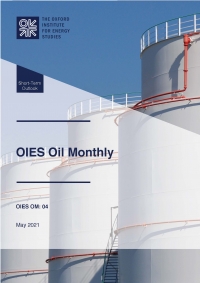OIES: Oil Monthly - Issue 4 - May 2021 - eng (pdf) Избранное
Данный выпуск обзора устарел, выпуск обзора за последний месяц находится по ссылке здесь.
The new issue of OIES Oil Monthly including our latest short-term oil market outlook is now available.
In this month’s featured In Focus piece, Bassam Fattouh and Andreas Economou argue that as in previous cycles, US shale will remain a key factor shaping market outcomes. The US shale response has been sharp and fast during the COVID-19 cycle and despite the recent improvement in prices, US shale output was still lower by 1.4 mb/d at the of end 2020 compared to a year earlier. A key feature of the current cycle is the longer lags between the price, rig count and US shale output. These longer lags, among other factors, imply that US shale will not disrupt oil balances in 2021, and we project output to contract by 380,000 b/d y/y. But as we enter 2022 the picture becomes more uncertain with US shale production projected to grow by 0.95 mb/d y/y but with the bands widening around our estimates. While impressive, the recovery is uneven across shale plays and by the end of 2022, production will still be below the 2019 peak.
Despite the sharp rise in COVID cases in India and elsewhere, confronted by the gradual unwinding of the OPEC+ output cuts in May/July 2021, oil prices appear well bounded in the $60/b and $70/b range throughout 2021 and 2022. In the very near-term, risks to the outlook are balanced but market uncertainties persist beyond 2021 pertaining to the supply side. The global demand recovery is moving at two speeds with the rebound in the OECD and China gaining traction, while other non-OECD are trying to cope with renewed COVID waves, severe delays in vaccinations and deeper economics impacts of the pandemic. Near-term supply is expected to increase gradually, with OPEC+ leading the rise. Despite recent headwinds, market deficits persist but the extent of the global oil demand rebound in H2 will shape market outcomes in 2021 and beyond.
Дополнительная информация
- Серия: Консалтинг и научные центры / Oxford Institute for Energy Studies / Oil Monthly
- Год: 2021
- Месяц: 5
- Источник: The Oxford Institute for Energy Studies
- OIES: Oil Monthly - Issue 4 - May 2021 - eng (pdf) (214 Скачиваний)


































